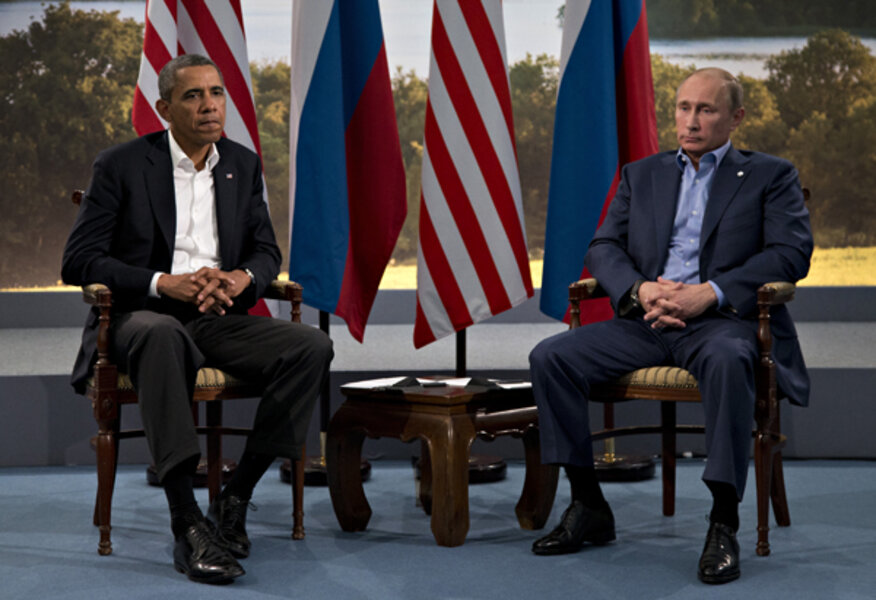How Russia views nuclear disarmament - and why it may resist
Loading...
| Moscow
President Barack Obama is urging Russia to move decisively beyond the cold war paradigm by negotiating a new round of arms reductions that would slash the numbers of nuclear weapons deployed by the US and Russia by one-third. It's a bold proposal that builds on a lot of historical success in the field of arms control. But it's not likely to be met with much enthusiasm in Moscow, where President Vladimir Putin has made anti-Americanism a central theme of his third presidential term, and the Russian military is extremely dubious about any further cuts in their already-overstretched nuclear deterrent.
Why is Obama proposing this idea now?
He's pitching it as part of the Global Nuclear Zero, a grand scheme supported by Mr. Obama and about 300 other world leaders to promote policies that will decrease and eventually eliminate atomic weapons from the Earth.
Even if it should prove unrealizable, it's an alluring idea that Obama may hope will focus public support and drive practical efforts to reduce the nuclear danger and build greater trust – especially between the US and Russia, who still own well over 90 percent of the world's existing nuclear weapons. During the cold war, the US and USSR signed a series of landmark arms-control treaties that tamed the nuclear "balance of terror" and went a long way toward stabilizing relations between two confrontational superpowers that held enough mega-tonnage between them to destroy the world many times over.
Early in his first term, Obama ended a long diplomatic chill with the Russians by engaging them in successful negotiations for the New START strategic arms reduction accord, which cut nuclear missile forces on both sides by almost half. Obama hopes to repeat that hat trick and arrest the current slide in US-Russia relations by enticing Moscow into a new, publicly popular round of nuclear arms-slashing.
How many nuclear weapons are there?
Under the terms of the New START treaty, the US and Russia are each allowed 1,550 strategic nuclear warheads, which means weapons that have intercontinental reach because they're based on long-range bombers, submarines, and missiles. Under Obama's fresh proposal, both sides would have to scale down to about 1,000 each.
But that's just the tip of the atomic iceberg. In addition, both sides maintain hundreds of "tactical" nuclear warheads, which are much harder to identify because they tend to be small and portable: for use in artillery shells, depth charges, short-range missiles, and other ordnance that's difficult to distinguish from conventional counterparts. According to the nonpartisan Arms Control Association, the US has about 500 of those, deployed on ships and at US military bases around the world, while Russia maintains around 2,000.
Seven other nuclear-armed powers, who have never been included in any arms control deals, hold significant numbers of warheads and increasingly sophisticated means of delivering them. They include Britain with an estimated 225, France with 300, China with 240, Pakistan and India with about 100 each, Israel with perhaps 80, and North Korea with less than 10.
Do the Russians view the basic issue differently from the US?
Very differently. Whereas the US divides its nuclear weapons among a "strategic triad" of bombers, missiles, and submarines, Russia's strategic weapons are mostly concentrated on a few hundred aging, land-based intercontinental ballistic missiles. The Russians feel they are more vulnerable to a crippling "first strike," and therefore need larger numbers of weapons to maintain a sufficient level of deterrence.
Moreover, the nuclear component in Russia's armed forces remains the only credible guarantee that Russia would win a war against any aggressor. Russia's conventional military remains a shambles, despite an urgent ten-year, $700 billion rearmament program initiated by President Vladimir Putin.
The US, on the other hand, spends about 7 times more than Russia on military effort, maintains a huge technological lead, and deploys vast, globe-girdling conventional forces that have no credible peers in today's world. Hence, the Americans can afford to talk up the idea of more drastic nuclear cuts, whereas Russia is likely to be far more cautious.
What about missile defense?
This is the main deal-breaker, from the Russian point of view.
When the US and the USSR began negotiating limits to their nuclear arsenals nearly half a century ago, they first signed the Anti-Ballistic Missile Treaty, which banned defensive weapons. That formalized the doctrine of "mutual assured destruction" – or MAD – meaning any nuclear attack by either side would bring a rapid, annihilating counterstrike.
In other words, the ABM deal was a suicide pact that effectively prevented either side from developing the capacity to launch a devastating first strike and hope to fend off retaliation with defensive weaponry. That left no alternative but to negotiate reductions in offensive missile forces down to stable and mutually acceptable levels.
But President George W. Bush withdrew unilaterally from the ABM treaty in 2002, and developed plans for globe-girdling missile-defense installations. That effort – and particularly the NATO branch of missile defense in Europe – is viewed by the Russians as an attempt to break out of MAD and potentially neutralize Russia's nuclear-missile deterrent.
Though the Obama administration has made key concessions to Moscow's concerns, the Russians still say they want ironclad guarantees that US anti-missile systems will never be used against them. Without that, the Russians may be loathe to discuss any further cuts to their offensive arsenal.






